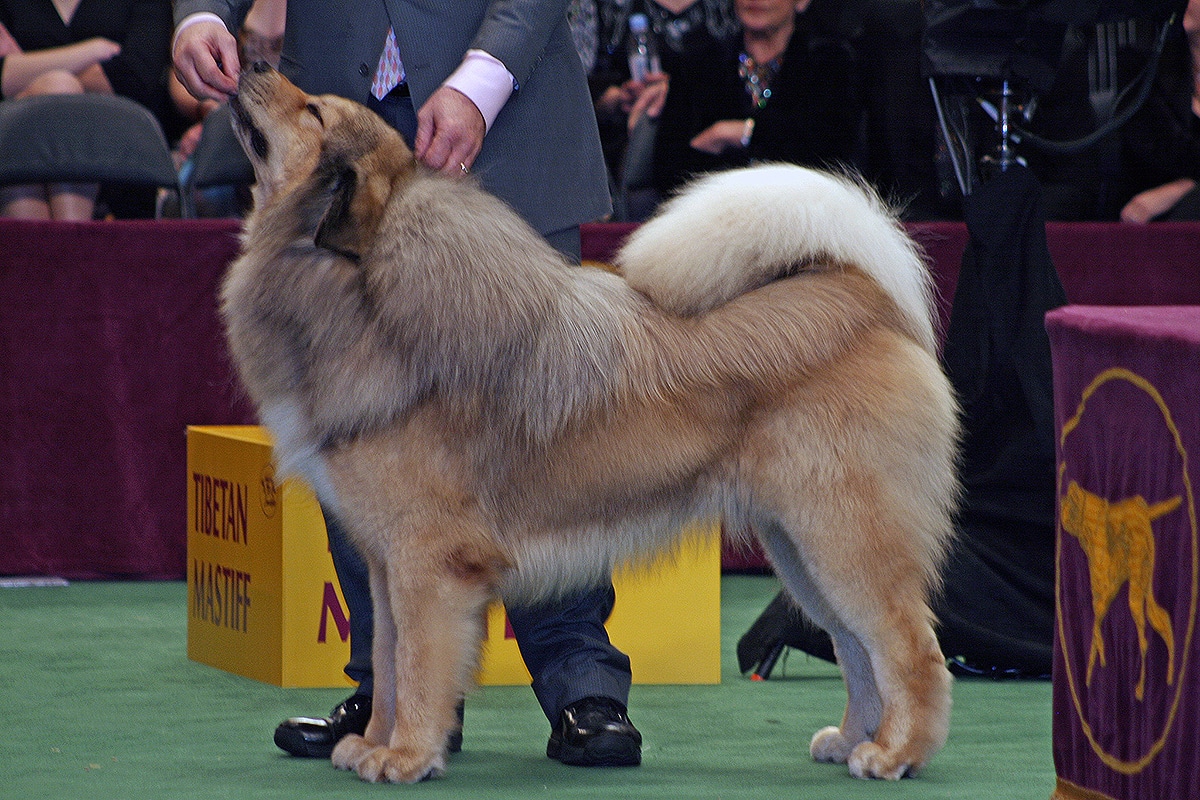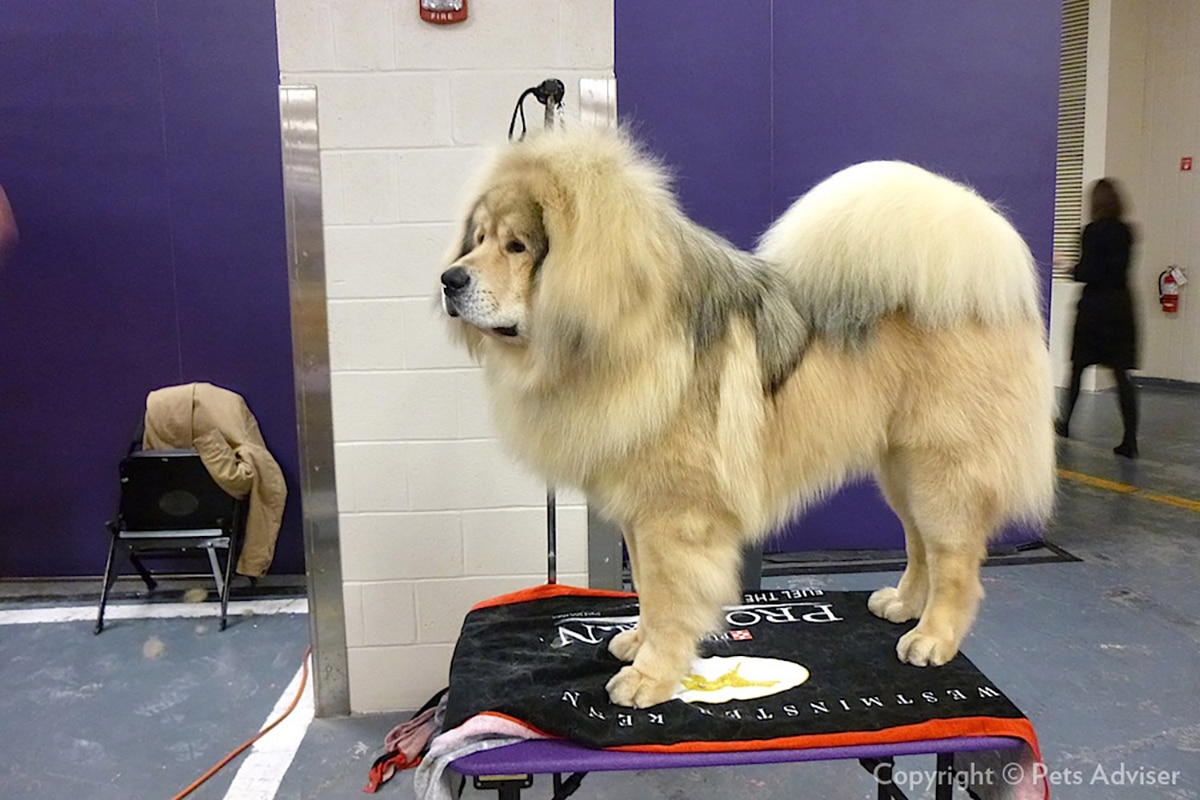
One of the oldest and largest dog breeds that exists today is the Tibetan Mastiff. This imposing dog has a very muscular body and stands out above all for the mane it has around its neck, similar to a lion. Although it is true that it is of Asian origin, today we can find it all over the world. It must be said that he is a very good companion and guard dog, but its dimensions, its character and coat make it require specific care.
If you are thinking of acquiring this dog breed or you are simply curious, I recommend that you take a look at this article. We will talk about the origins of the Tibetan Mastiff, about its character and about the care it requires.
Origins of the Tibetan Mastiff

As its name indicates, the Tibetan Mastiff, also known as Do-Khyi or Dogo del Tibet, is originally from Tibet. They used it as a guard dog there. In fact, it is possible that the other varieties of mastiffs that we know today come from him.
It is one of the oldest breeds, or so the experts believe. Texts have been found Aristotle and Marco Polo that mention this huge dog, which was distinguished mainly by its large size. Although these writings date back to before Christ, it took centuries for the Tibetan Mastiff to leave Asia. In the year 1847 this breed of dog was introduced in England. A couple of years later, two copies of the Tibetan Mastiff became part of the Berlin Zoo.
The basic characteristics of this dog breed are the following:
- Size: Around 66 centimeters in males and 61 centimeters in females.
- Weight: Between 40 and 68 kilos in males and between 31 and 54 kilos in females.
- Rough and abundant fur of fawn, black and fiery red.
- Protective, reserved and intelligent character.
- Regular health, since it usually suffers from certain congenital diseases.
- Life expectancy: Between 10 and 12 years.
Description
When we talk about the Tibetan Mastiff, we refer to a giant and corpulent breed of dog. His body is very muscular and molossoid. Regarding the tail, it is curved and very woolly. It usually rests on the dog's back.
The head of this animal is strong and adults usually have a wrinkle on their face. As for the snout, it is deep and wide and has a dark nose whose nostrils are dilated. It has a rectangular jaw and its dental rows fit together perfectly, which is why it is said that has a pincer or scissor bite. The eyes of the Dogue del Tibet are oval and the iris usually has different shades of brown. Of the head we still have to mention the ears, which have a triangular shape and usually fall on the face.
Due to the great fur that this dog breed has, it is often compared to a bear or a lion. It has a double coat: the outer layer is of medium length and quite dense and rough, while the inner layer is very woolly. The hair of this dog is hard and tends to grow more and accumulate especially around the neck. Regarding the color of the coat, this can be very varied today. But the most common is that it is black with some reddish areas, or bluish with sable or golden areas (similar to the German shepherd).
Tibetan Mastiff care

As expected due to its size, the Tibetan Mastiff is not the ideal dog for a flat. You need a lot of space to be able to move around without breaking anything or getting frustrated. Also, its dense fur is designed to withstand the cold, Therefore, very hot areas are not the most suitable for this breed, although it can withstand high temperatures. Another aspect to keep in mind with the coat is that it requires some maintenance. It is best to brush it 2 or 3 times a week.
Contrary to what we might think due to its large size, the Tibetan Mastiff should exercise moderately. It is best to walk him daily, but avoid forcing him to run or play chase games for a long time. During colder times, the dog may be more predisposed to this type of activity.
Regarding food, it must be of quality, as with all animals. However, since it is a very large dog, it is highly advisable use chondroprotectors as a food supplement to keep your joints healthy.
Finally, we have to mention that it is a dog breed prone to certain pathologies, something that can make its maintenance more expensive. These are the most frequent diseases of the Tibetan Mastiff:
- Hip dysplasia
- Elbow dysplasia
- Entropion
- Hypothyroidism
How aggressive is the Tibetan Mastiff?
Now that we know a little more about the Tibetan Mastiff and its care, let's see what its character is. He generally has a strong temperament, but at the same time bearable. He stands out above all for his great intelligence and his utmost loyalty to the family. It is a very protective and territorial dog. which is why you can have certain dangerous brushes with strangers. It is not really an aggressive dog, but it can cause problems if it is not socialized and educated well as a puppy, especially regarding its territoriality. It should be noted that it is not a dog suitable for people without experience in dog training.
In general, this dog is independent and brave and it is not uncommon for him to make decisions on his own. Although it is true that he can be very devoted and sweet with the family, his attitude towards strangers is cautious, like the good guard dog that he is. It is not recommended to take him for a walk without a leash, since his territoriality and his predisposition to make decisions on his own can end up in a fight with other dogs, not to mention the scare that the neighbors can get.
As you can see, the Tibetan Mastiff is an imposing dog and friend of the human being, but it requires knowledge about its breed.